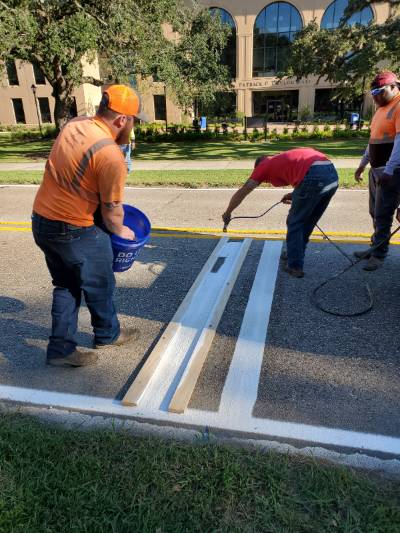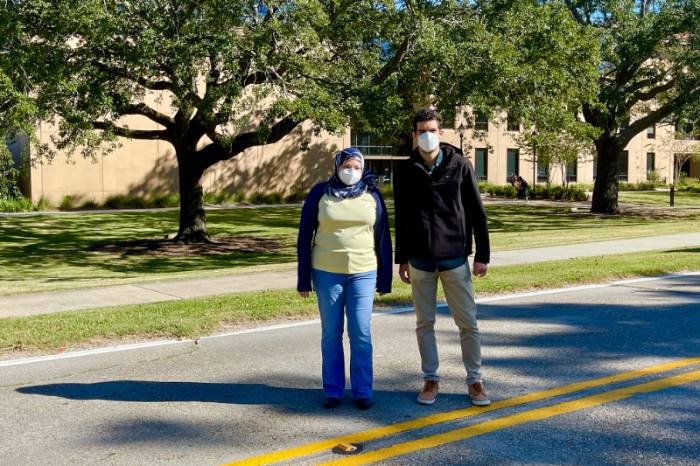LSU CM Researchers Study Pavement Markings and Bio-Concrete
November 30, 2020
 BATON ROUGE, LA – With 230 million licensed drivers in the United States, road safety
and infrastructure are of the utmost importance.
BATON ROUGE, LA – With 230 million licensed drivers in the United States, road safety
and infrastructure are of the utmost importance.
LSU Construction Management Research Associate Momen Mousa, who is also Tran-SET (Transportation Consortium of South Central States) program manager; LSU Construction Management Professor Marwa Hassan, who is also director of Tran-SET and president of the Construction Research Congress; and LSU Research Assistant Professor Gabriel Arce are working together on a few projects sponsored by the U.S. Department of Transportation that will save time and money; enhance drivers’ safety; and improve America’s roads. Here are two of those projects.
Pavement Markings
One project will develop new restriping strategies when using waterborne paints for markings on asphalt pavements in the southern United States. Mousa and Hassan are collaborating with Paul Carlson, chief technology officer at Road Infrastructure Investment Holdings, to determine how long pavement markings will last.
“The Louisiana DOTD assumes the life of the pavement marking paints is two years, regardless of the road conditions,” Mousa said.
If the markings are replaced too soon, state agencies are wasting their money. However, if the markings are replaced too late, it could be a major safety hazard for drivers. Currently, there is only one initial retroreflectivity measurement taken on markings in Louisiana, but the degradation is not monitored. Retroreflectivity measurements determine if the markings are retroreflective enough for drivers to see at night.
“We developed a model that state agencies can use to predict the service life of their pavement markings, based on the road conditions, without the need of additional measurements,” Mousa said. “Based on this model, state agencies will know the optimum time to restripe their roads.”
In order to validate this model, Mousa and Hassan collaborated with Stripe-A-Zone, a road construction firm in Texas and Louisiana, which applied five different marking materials (paints and thermoplastic) to asphalt and concrete surfaces on LSU’s campus—Highland Road, Nicholson Extension, Engineering Lane, and Forestry Lane—on Oct. 16-17. Mousa and Hassan plan to monitor the degradation of these markings over 15 months.
“A problem we have is that the service life is longer than our allotted project time, and there is not much traffic on campus currently due to the pandemic,” Mousa said.
In order to combat this problem, the field-testing at LSU included accelerated testing by applying the marking materials in a transverse direction (in addition to the conventional longitudinal direction) to be subjected to more traffic wear. This will allow the comparison of different marking materials within the project time.
Bio-Concrete
 Mousa, Hassan and Arce’s second project is to determine the optimal parameters for
self-healing efficiency of encapsulated bacteria in concrete in a stimulated subtropical
climate.
Mousa, Hassan and Arce’s second project is to determine the optimal parameters for
self-healing efficiency of encapsulated bacteria in concrete in a stimulated subtropical
climate.
“The main reason we started this project was to enhance the durability of concrete pavements and reduce maintenance costs,” Mousa said. “When pavements crack, water gets inside and accelerates the rate of deterioration. We want to develop innovative concrete materials that can self-heal.”
There are various self-healing techniques for concrete, with the most common being the use of bacteria in concrete, which can seal crack widths up to 1 mm wide without human intervention. The self-healing process entails embedding alkali-resistant bacterial spores in concrete to precipitate calcium carbonate. The success of this method depends on four factors—water, oxygen or nitrate, nutrient for the bacteria, and calcium source.
There are three ways to encapsulate the bacteria into the concrete—calcium alginate beads, vacuum-impregnation into bagasse fibers (a sugar cane byproduct), and vacuum-impregnation into porous aggregates. A total of 37 mortar mixtures will be prepared, tested, and monitored. Two of the best-performing mortar mixtures will be upscaled and retested in concrete samples.
Like us on Facebook (@lsuengineering) or follow us on Twitter and Instagram (@lsuengineering).
###
Contact: Libby Haydel
Communications Specialist